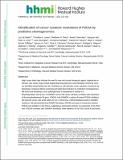| dc.contributor.author | de Waal, Luc | |
| dc.contributor.author | Lewis, Timothy A | |
| dc.contributor.author | Rees, Matthew G | |
| dc.contributor.author | Tsherniak, Aviad | |
| dc.contributor.author | Wu, Xiaoyun | |
| dc.contributor.author | Choi, Peter S | |
| dc.contributor.author | Gechijian, Lara | |
| dc.contributor.author | Hartigan, Christina | |
| dc.contributor.author | Faloon, Patrick W | |
| dc.contributor.author | Hickey, Mark J | |
| dc.contributor.author | Tolliday, Nicola | |
| dc.contributor.author | Carr, Steven A | |
| dc.contributor.author | Clemons, Paul A | |
| dc.contributor.author | Munoz, Benito | |
| dc.contributor.author | Wagner, Bridget K | |
| dc.contributor.author | Shamji, Alykhan F | |
| dc.contributor.author | Schenone, Monica | |
| dc.contributor.author | Burgin, Alex B | |
| dc.contributor.author | Schreiber, Stuart L | |
| dc.contributor.author | Greulich, Heidi | |
| dc.contributor.author | Meyerson, Matthew | |
| dc.contributor.author | Koehler, Angela Nicole | |
| dc.date.accessioned | 2017-02-15T20:57:06Z | |
| dc.date.available | 2017-02-15T20:57:06Z | |
| dc.date.issued | 2015-12 | |
| dc.date.submitted | 2015-03 | |
| dc.identifier.issn | 1552-4450 | |
| dc.identifier.issn | 1552-4469 | |
| dc.identifier.uri | http://hdl.handle.net/1721.1/106947 | |
| dc.description.abstract | High cancer death rates indicate the need for new anticancer therapeutic agents. Approaches to discovering new cancer drugs include target-based drug discovery and phenotypic screening. Here, we identified phosphodiesterase 3A modulators as cell-selective cancer cytotoxic compounds through phenotypic compound library screening and target deconvolution by predictive chemogenomics. We found that sensitivity to 6-(4-(diethylamino)-3-nitrophenyl)-5-methyl-4,5-dihydropyridazin-3(2H)-one, or DNMDP, across 766 cancer cell lines correlates with expression of the gene PDE3A, encoding phosphodiesterase 3A. Like DNMDP, a subset of known PDE3A inhibitors kill selected cancer cells, whereas others do not. Furthermore, PDE3A depletion leads to DNMDP resistance. We demonstrated that DNMDP binding to PDE3A promotes an interaction between PDE3A and Schlafen 12 (SLFN12), suggestive of a neomorphic activity. Coexpression of SLFN12 with PDE3A correlates with DNMDP sensitivity, whereas depletion of SLFN12 results in decreased DNMDP sensitivity. Our results implicate PDE3A modulators as candidate cancer therapeutic agents and demonstrate the power of predictive chemogenomics in small-molecule discovery. | en_US |
| dc.language.iso | en_US | |
| dc.publisher | Nature Publishing Group | en_US |
| dc.relation.isversionof | http://dx.doi.org/10.1038/nchembio.1984 | en_US |
| dc.rights | Article is made available in accordance with the publisher's policy and may be subject to US copyright law. Please refer to the publisher's site for terms of use. | en_US |
| dc.source | PMC | en_US |
| dc.title | Identification of cancer-cytotoxic modulators of PDE3A by predictive chemogenomics | en_US |
| dc.type | Article | en_US |
| dc.identifier.citation | de Waal, Luc et al. “Identification of Cancer-Cytotoxic Modulators of PDE3A by Predictive Chemogenomics.” Nature Chemical Biology 12.2 (2015): 102–108. | en_US |
| dc.contributor.department | Massachusetts Institute of Technology. Department of Biological Engineering | en_US |
| dc.contributor.department | Koch Institute for Integrative Cancer Research at MIT | en_US |
| dc.contributor.mitauthor | Koehler, Angela Nicole | |
| dc.relation.journal | Nature Chemical Biology | en_US |
| dc.eprint.version | Author's final manuscript | en_US |
| dc.type.uri | http://purl.org/eprint/type/JournalArticle | en_US |
| eprint.status | http://purl.org/eprint/status/PeerReviewed | en_US |
| dspace.orderedauthors | de Waal, Luc; Lewis, Timothy A; Rees, Matthew G; Tsherniak, Aviad; Wu, Xiaoyun; Choi, Peter S; Gechijian, Lara; Hartigan, Christina; Faloon, Patrick W; Hickey, Mark J; Tolliday, Nicola; Carr, Steven A; Clemons, Paul A; Munoz, Benito; Wagner, Bridget K; Shamji, Alykhan F; Koehler, Angela N; Schenone, Monica; Burgin, Alex B; Schreiber, Stuart L; Greulich, Heidi; Meyerson, Matthew | en_US |
| dspace.embargo.terms | N | en_US |
| mit.license | PUBLISHER_POLICY | en_US |
